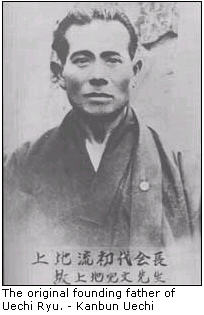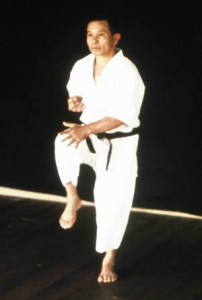Kanbun Uechi
 Kanbun Uechi studied Pangai-noon (half-hard, half-soft) under Shushiwa in the Fujian (a.k.a. Fukien) province of mainland China in the late 19th century and early 20th century. After studying 10 years under Shushiwa, Kanbun Uechi opened his own school in the province of Nanjing.
Kanbun Uechi studied Pangai-noon (half-hard, half-soft) under Shushiwa in the Fujian (a.k.a. Fukien) province of mainland China in the late 19th century and early 20th century. After studying 10 years under Shushiwa, Kanbun Uechi opened his own school in the province of Nanjing.
Two years later, Kanbun Uechi returned to Okinawa, determined never to teach again because one of his Chinese students had killed a neighbour with an open-hand technique in a dispute over land irrigation. While he was working as a janitor he was persuaded by a co-worker, Ryuyu Tomoyose, to teach again after having been first convinced to show Tomoyose ways of defending himself against different attacks.
When his confidence as a teacher was restored, Uechi, with the help of Ryuyu Tomoyose, moved to Wakayama City, Wakayama Prefecture, where, in 1925, he established the Institute of Pangainun-ryū (half-hard half-soft) Todi-jutsu, and opened a dojo to the public. Eventually, in 1940, his Okinawan students renamed the system as “Uechi Ryū”.
Kanei Uechi

Kanei Uechi
Kanbun Uechi’s son, Kanei Uechi, taught the style at the Futenma City Dojo, Okinawa, and was considered the first Okinawan to sanction teaching foreigners. Uechi Ryū emphasizes toughness of body with quick blows and kicks. Some of the more distinctive weapons of Uechi practitioners are the one-knuckle punch (shoken), spearhand (nukite), and the toe kick (shomen geri). On account of this emphasis on simplicity, stability, and a combination of linear and circular movements, proponents claim the style is more practical for self-defense than most other martial arts.
Peter McRae has studied and practiced Uechi-Ryu karate for well over thirty years, with many visits to Okinawa and direct training with Kanei Uechi in the Futenma Dojo while Master Uechi was still alive.